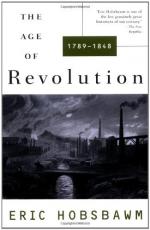
|
| Name: _________________________ | Period: ___________________ |
This test consists of 15 multiple choice questions and 5 short answer questions.
Multiple Choice Questions
1. What landmark event does Hobsbawm use as the beginning of the middle class ideology?
(a) The publication of "Jane Eyre".
(b) The publication of 'Wealth of Nations".
(c) The publication of Hobbes' "Leviathan".
(d) The publication of "Bleak House".
2. What was increasing at the same time that the railroads were expanding in the 1830s?
(a) Religion.
(b) Monarchy.
(c) Superstition.
(d) Migration.
3. Which musician did NOT rise to prominence during the Age of Revolution?
(a) Bach.
(b) Schumann.
(c) Schubert.
(d) Beethoven.
4. What possibility did this social structure open to French society?
(a) It became a place where talent could succeed regardless of wealth or birth.
(b) It became a place where the monarch could appoint friends and supporters.
(c) It became a place where new immigrants could attain citizenship.
(d) It became a place where aristocrats could regain their property and standing.
5. What role did Chartists play in politics?
(a) They disrupted the political process.
(b) They agitated for liberal politicians.
(c) They agitated for conservative politicians.
(d) They were elected to local councils.
6. Which religion was expanding from Turkey through Africa and to the east?
(a) Confucianism.
(b) Shinto.
(c) Hinduism.
(d) Islam.
7. What changed in other countries, but did not change in France, in Hobsbawm's analysis?
(a) France did not begin to idealize its ancient past.
(b) Mercantile colonialism did not provide large amounts of revenue.
(c) Population did not increase.
(d) Inflation did not remain low.
8. What contrast became very clear as industrialism developed in Europe?
(a) The contrast between men's and women's employments.
(b) The contrast between working poor and middle class.
(c) The contrast between Eastern and Western European.
(d) The contrast between bourgeoisie and aristocracy.
9. How did Hobsbawm characterize the change in the way that people related to the land, and the way land was related to the economy?
(a) As the most lucrative development of the period.
(b) As the least recognized phenomenon of the period.
(c) As the least forgivable development of the period.
(d) As the most catastrophic phenomenon of the period.
10. Where was Chartism an active part of the political landscape?
(a) France.
(b) Austria.
(c) Prussia.
(d) Britain.
11. Which form of rebellion did the working poor NOT engage in?
(a) Political campaigns.
(b) Demonstrations.
(c) Strikes and riots.
(d) Organized terrorism.
12. In Hobsbawm's account, what did the peasantry lose by land reforms sweeping the globe in the mid-1800s?
(a) Freedom.
(b) Dependence on local government.
(c) Protections.
(d) Ambition.
13. How were the working classes influenced by religion after the French Revolution?
(a) They relied on it as another social service.
(b) They remained tithed to the church.
(c) They found consolation in the church for their hard lives.
(d) The were less influenced by it than before.
14. In Hobsbawm's account, what happened in France as industrialism expanded in neighboring countries?
(a) Land reforms from the French Revolution tied land use to the peasantry, and the economy did not take off.
(b) France industrialized quickly, as the soldiers returned from the Napoleonic Wars and went to work in factories.
(c) The economy was paralyzed by the veterans returning from the wars to the small plots of land Napoleon had promised.
(d) Economic development was slow for lack of investors willing to put money in French factories.
15. What is the paradox in France's failure to develop its industries?
(a) The workers became more efficient, but the cost of living skyrocketed.
(b) The aristocracy lost the land, but retained the right to what the land produced.
(c) The peasants had more autonomy as a result of land reforms, but they were not well positioned to capitalize on their land.
(d) The peasants gained more political power, but with so many voices, the government was paralyzed.
Short Answer Questions
1. What was a consequence of the emergence of a new class of people in European society?
2. What developed in other European countries, but not in France?
3. What was the status of the Catholic Church after the French Revolution?
4. In what way, in Hobsbawm's account, did the nobility use religion?
5. What change does Hobsbawm say took place in the neighborhoods of the working poor?
|
This section contains 733 words (approx. 3 pages at 300 words per page) |

|




